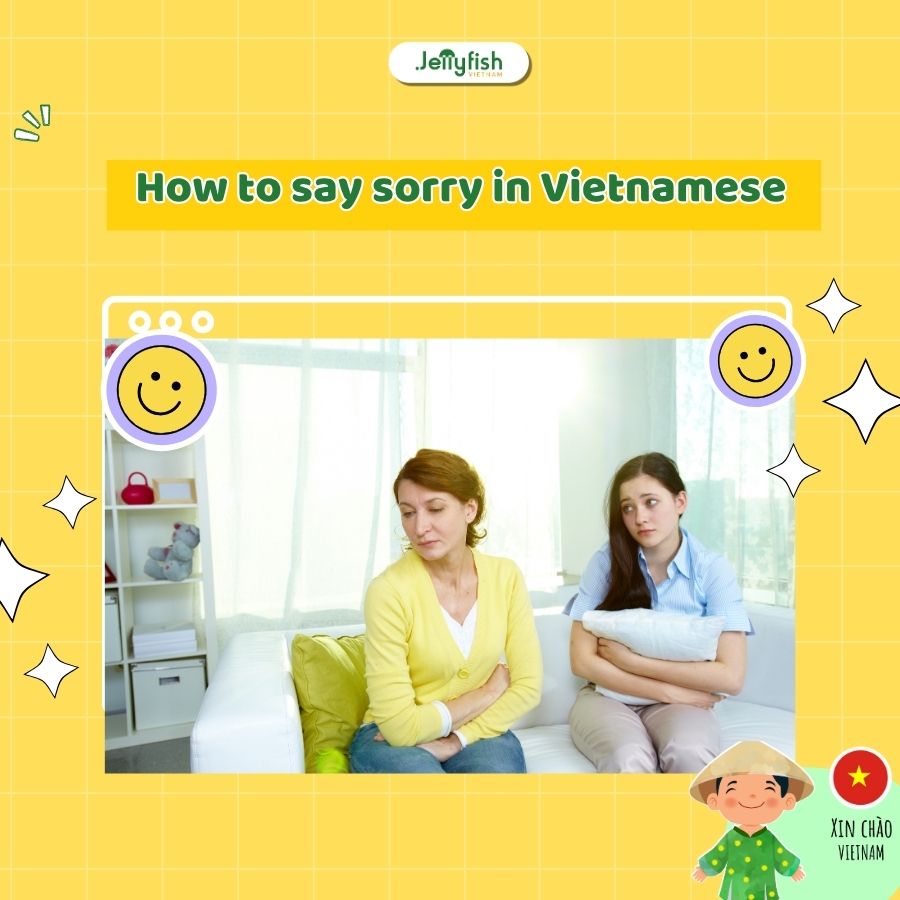Apologizing in any language is an important way to show respect, humility, and emotional intelligence — and Vietnamese is no exception. Whether you make a mistake at work, bump into someone on the street, or need to politely decline an invitation, knowing how to say sorry in Vietnamese can help you handle situations with grace. In this guide, Jellyfish teaches you how to say sorry in Vietnamese, using the right tone, vocabulary, and cultural sensitivity.
1. The most common way to say sorry in Vietnamese
Xin lỗi
This is the most universal and commonly used phrase for “I’m sorry” in Vietnamese. It can be used in both formal and casual contexts, and works well in most situations.
Examples:
- Xin lỗi, tôi đến muộn. → I’m sorry I’m late.
- Xin lỗi bạn, mình không cố ý. → Sorry, I didn’t mean to.
- Xin lỗi anh/chị. → Sorry, sir/ma’am. (more respectful)
Adding a pronoun like “anh”, “chị”, “em”, or “bạn” makes your apology sound more personal and polite.
2. Polite ways to say sorry in Vietnamese
In formal situations or when the mistake is more serious, you can use these more polite and sincere forms:
- Tôi thành thật xin lỗi. → I sincerely apologize.
- Xin gửi lời xin lỗi chân thành đến… → I would like to extend my sincere apologies to…
- Tôi rất tiếc về việc đó. → I deeply regret that.
These are especially helpful in emails, business settings, or public speaking.
3. Casual and friendly apologies

When speaking with friends, classmates, or people you know well, you can use more relaxed expressions:
- Xin lỗi nha. → Sorry (casual, soft)
- Mình xin lỗi nhé. → I’m sorry, okay? (gentle tone)
- Sorry nha! → Sorry! (modern, influenced by English – used in texts or chats)
- Xin lỗi vì đã làm phiền. → Sorry for bothering you.
These are useful for small mistakes, minor delays, or informal chats.
4. How to respond to an apology in Vietnamese
Just like in English, it’s polite to respond when someone apologizes to you.
Here are some common replies:
- Không sao đâu. → It’s okay. / No problem.
- Không có gì. → It’s nothing.
- Không cần xin lỗi. → No need to apologize.
- Tôi hiểu mà. → I understand.
These phrases help maintain harmony and show that you’re not offended.
5. Saying “sorry” in specific situations
Here’s how to say sorry in Vietnamese depending on the context:
When you’re late:
- Xin lỗi, tôi đến trễ. → Sorry I’m late.
- Mình xin lỗi vì làm bạn đợi. → I’m sorry for making you wait.
At work or school:
- Xin lỗi vì đã không hoàn thành công việc đúng hạn.
→ I apologize for not finishing the work on time. - Tôi rất tiếc vì sự bất tiện này. → I deeply regret the inconvenience.
Bumping into someone:
- Xin lỗi ạ! → Sorry! (add “ạ” to show politeness)
- Cho tôi xin lỗi nhé. → Please forgive me. (casual)
Declining an invitation:
- Xin lỗi, tôi không thể tham gia. → Sorry, I can’t join.
- Rất tiếc, hôm đó tôi bận. → I’m really sorry, I’m busy that day.
6. Cultural tips on apologizing in Vietnam
- Use proper pronouns: Always adjust your “xin lỗi” to the age or status of the person (e.g., “xin lỗi anh” vs. “xin lỗi em”).
- Tone matters: Apologies should sound genuine — avoid laughing while saying sorry, which may be seen as insincere.
- Non-verbal cues: A slight bow or placing your hand over your chest shows sincerity.
- Don’t over-apologize: Vietnamese people often accept apologies quickly; saying sorry too much may seem awkward.
7. Practice
Part 1: Vocabulary Matching
Match the Vietnamese phrase with the correct English meaning.
| A | Vietnamese | B | English |
| 1 | Xin lỗi | a | I’m sorry (formal/polite) |
| 2 | Em xin lỗi | b | I’m sorry (younger to older) |
| 3 | Anh xin lỗi | c | I’m sorry (male speaker) |
| 4 | Tôi xin lỗi | d | I apologize (neutral/formal) |
Answer key:
1 – a
2 – b
3 – c
4 – d
Part 2: Choose the Right Response
Conclusion
Saying sorry the right way can help you earn trust and build respect in Vietnamese culture. From quick casual phrases to heartfelt formal apologies, now you know exactly how to say sorry in Vietnamese with confidence and clarity.
Learn Vietnamese the real way with Jellyfish
At Jellyfish, we don’t just teach words — we teach you how to use them in context. Our courses are perfect if you want to:
- Speak naturally in real-life situations
- Understand cultural nuances like apologies and politeness
- Practice with native teachers and real conversation topics
👉👉 Learning Vietnamese – Jellyfish Vietnam
✦ Hotline: 096 110 6466
✦ Head office: 1st Floor, Web3 Tower Building, Alley 4 Duy Tan Street, Cau Giay District, Hanoi
✦ Branch office: 2rd Floor, SH5.11 Vinhomes Marina, Vinh Niem, Le Chan, Haiphong
✦ Head office in Japan: 4F Westhill Building, Nishigotanda 2-24-4, Shinagawa, Tokyo, Japan


